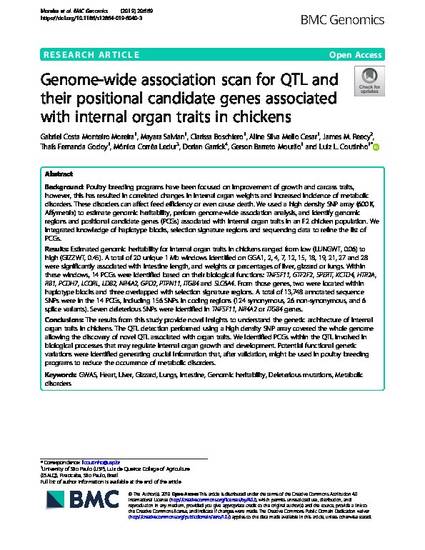
Background: Poultry breeding programs have been focused on improvement of growth and carcass traits, however, this has resulted in correlated changes in internal organ weights and increased incidence of metabolic disorders. These disorders can affect feed efficiency or even cause death. We used a high density SNP array (600 K, Affymetrix) to estimate genomic heritability, perform genome-wide association analysis, and identify genomic regions and positional candidate genes (PCGs) associated with internal organ traits in an F2 chicken population. We integrated knowledge of haplotype blocks, selection signature regions and sequencing data to refine the list of PCGs.
Results: Estimated genomic heritability for internal organ traits in chickens ranged from low (LUNGWT, 0.06) to high (GIZZWT, 0.45). A total of 20 unique 1 Mb windows identified on GGA1, 2, 4, 7, 12, 15, 18, 19, 21, 27 and 28 were significantly associated with intestine length, and weights or percentages of liver, gizzard or lungs. Within these windows, 14 PCGs were identified based on their biological functions: TNFSF11, GTF2F2, SPERT, KCTD4, HTR2A, RB1, PCDH7, LCORL, LDB2, NR4A2, GPD2, PTPN11, ITGB4 and SLC6A4. From those genes, two were located within haplotype blocks and three overlapped with selection signature regions. A total of 13,748 annotated sequence SNPs were in the 14 PCGs, including 156 SNPs in coding regions (124 synonymous, 26 non-synonymous, and 6 splice variants). Seven deleterious SNPs were identified in TNFSF11, NR4A2 or ITGB4 genes.
Conclusions: The results from this study provide novel insights to understand the genetic architecture of internal organ traits in chickens. The QTL detection performed using a high density SNP array covered the whole genome allowing the discovery of novel QTL associated with organ traits. We identified PCGs within the QTL involved in biological processes that may regulate internal organ growth and development. Potential functional genetic variations were identified generating crucial information that, after validation, might be used in poultry breeding programs to reduce the occurrence of metabolic disorders.
Available at: http://works.bepress.com/james_reecy/143/

This article is published as Moreira, Gabriel Costa Monteiro, Mayara Salvian, Clarissa Boschiero, Aline Silva Mello Cesar, James M. Reecy, Thaís Fernanda Godoy, Mônica Corrêa Ledur, Dorian Garrick, Gerson Barreto Mourão, and Luiz L. Coutinho. "Genome-wide association scan for QTL and their positional candidate genes associated with internal organ traits in chickens." BMC Genomics 20 (2019): 669. doi: 10.1186/s12864-019-6040-3.